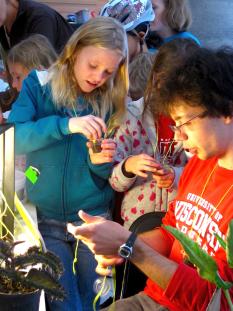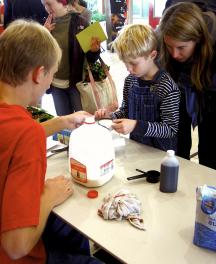






 Protein extraction and freezing point depression are not the ordinary selling points for a juicy bratwurst and a fresh batch of vanilla ice cream.
Protein extraction and freezing point depression are not the ordinary selling points for a juicy bratwurst and a fresh batch of vanilla ice cream.
But attendees of the Wisconsin Science Festival were not looking for the ordinary, and presenters were happy to oblige.
With the art of bratwurst on the agenda, as well as a presentation explaining why beer was actually the catalyst for civilization, it wasn’t difficult to understand why Wisconsin culture is so inextricably linked with its edibles.
Brewing beer: its significance and science
Much of the Festival took place in the Wisconsin Institutes for Discovery building, and several University of Wisconsin – Madison researchers participated.
Jon Roll, a professor in the bacteriology department who teaches a brewing course, spoke about the history and science behind Wisconsin’s fermented favorite.
Roll suggested that beer has been central to civilization since the beginning, and that nomadic behavior was curtailed by the desire to grow grains for beer production.
He referenced Egyptian brewing hieroglyphs to give a sense of the drink’s historic significance, and also highlighted beer’s place in one of colonial America’s first moments.
The Mayflower stopped at Plymouth Rock because they were running low on beer, he said with a grin.
The state of Wisconsin has been the backdrop for some of the most notable moments in the country’s brewing history.
UW-Madison houses the only federally-funded barley malt testing facility. The lab was established, Boll explained, when Prohibition ended and farmers needed to rebuild the best strains of barley for brewing. He added that the lab tests any sample of barley for malting properties at no charge.
Citing the German regulation of brewing ingredients as the oldest food quality regulation on record, Roll discussed the science behind the pint. Distinguishing between ale and lager yeast strains, and explaining the physiology of barley varieties, he led listeners through the complex world of beer production.
“Many, many factors influence the quality of beer,” Roll stated. “I’m amazed that big brewers can produce their beers consistently over and over again.”
Miller Coors Brewing Company donated $250,000 of brew house equipment for Roll and his students to learn the ins and outs of their trade.
Brothers, Karl and Jack Aldinger, were in attendance. They chose to visit the science festival to celebrate Jack’s birthday.
“We enjoyed learning about the complexity of beer, and just the whole brewing process,” Jack said.
Processing bratwursts: the science behind a high quality sausage
Another big “B” in Wisconsin’s food culture is bratwurst.
About 40 meters away from Roll, Jeff Sindelar, UW-Madison meat science professor and extension meat specialist, told of the story of bratwurst, from slaughter to sausage.
When you pick up a brat package, the color of meat you see is determined in part by one of the first decisions processors make, he told the audience.
If an animal’s meat is removed immediately after slaughter and ground for brats right away, this is referred to as a pre-rigor process.
“The pre-rigor process preserves color, juiciness and it’s a better product,” he said.
There is less opportunity for lactic acid generation in the muscle, which would increase the acidity, or lower the pH, of the meat, Sindelar explained. “A lower pH takes the meat from a nice rich cherry red to more of a brown color,” he said. Adding seasoning to the freshly ground meat
Adding seasoning to the freshly ground meat
With the presentation in progress, Sindelar’s assistant, Amanda King, a PhD student in meat science, ground a slab of meat and made links to give festival-goers a brat-making close up. Responding to a call for volunteers, a young girl stepped forward to help mix spices into the freshly ground pork.
Glancing at the seasoning efforts, Sindelar mentioned that a good bratwurst is mixed just enough so as to just combine the meat and spices. The longer you mash the meat, the more proteins are extracted, making the meat mixture sticky, and resulting in a rubbery bratwurst.
Kris and Dan Labby, a married couple from Shawano, watched Sindelar’s bratwurst presentation.
“We have an MD, a medical physicist and an RN in our family,” they explained. “Our family is involved in science so we were curious to see the festival.”
They were especially interested to hear Sindelar address a question regarding the use of sodium nitrates in sausage and its potential health risks.
After the presentation, Sindelar commented that the audience had seemed unusually science-savvy.
“It’s a really neat consumer subset,” he said. “The way they were asking questions, they may not have had a classical background, but they were involved and passionate.”
Shaking it up: a quick ice cream treat
 Volunteer, Eric Wise, looks on as two kids pull their freshly made ice cream out of the ice bathAnother festival demonstration representing a third Wisconsin cultural food staple had a less-experienced clientele.
Volunteer, Eric Wise, looks on as two kids pull their freshly made ice cream out of the ice bathAnother festival demonstration representing a third Wisconsin cultural food staple had a less-experienced clientele.
Children of all ages stepped up to the “Art and Science of Ice Cream” booth to make their very own creamy treat.
Volunteer Eric Wise, an MATC student in liberal arts and biotechnology, helped kids combine milk, sugar and vanilla in a small sealable bag and turn it into Wisconsin’s frozen favorite.
Kids dropped their bag of sweetened milk into a container of ice and salt, shook it for a few minutes and then pulled out their newly solid treat. It was like watching them reach into a treasure chest and come out with a handful of solid gold.
The volunteers explained to the kids why the salt was added to the ice, to lower the freezing point of water.
“I’ve had an interest in science since the age of 5,” Wise said. “I just love science and wanted to help out.”
One festival-goer suggested that the real science of ice cream was how to avoid brain freeze. Milk+vanilla+sugar+cold = ice cream!
Milk+vanilla+sugar+cold = ice cream!
“You just have to avoid touching the sensory area at the top of your mouth,” a volunteer told him. “But that can be really hard.”
Though the science of food and drink was well represented at the festival, it only comprised a small percentage of the exhibits. The event was a tribute to diverse and creative research exploring all parts of the earth.
Andrea and Dennis Trinkle, residents of Eagle Heights brought their two children, Dora, 8, and Dominic, 7, to take part in the celebration of all things science.
“We want to show our kids the wonder of physics,” Dennis said.
|
|
|
Welcome to the Madison Commons, a website designed to provide news and information about all of Madison's neighborhoods and a crossroads for the discussion of community issues. The name comes from the idea of a village commons, a place for news, talk, debate, and some entertainment, too, that's open to everyone.
All rights reserved. Read more about the Madison Commons and its partners.

